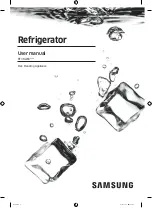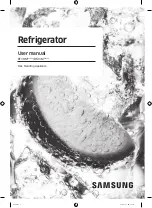
Instructions for Use
12
After cleaning return the appliance to its place, plug in the
power mains cord and fill with food.
Switch off the appliance when not in use
If you do not intend to use the appliance for a longer period, set
the thermostat knob to the
STOP (0)
position, disconnect the
power supply, take out the food and defrost and clean the
appliance. Leave the door slightly open.
Troubleshooting guide
During the service, you can come across some problems that
in most cases result from improper handling of the appliance
and can easy be eliminated.
The appliance fails to operate after connecting to the
mains supply
Check the supply in the outlet socket and make sure the
appliance is switched on (thermostat knob in operating
position).
Continuous operation of the cooling system
The door was frequently opened or it was left opened for too
long.
The door is not properly closed (the door may sag; the
gasket may be polluted or damaged).
Perhaps you have overloaded the appliance with fresh food.
Insufficient cooling of compressor and condenser.
Check the air circulation through the bottom rail openings
and clean or vacuum the dust from the condenser if
necessary. See section
Cleaning and maintenance.
Ice Formation on the inner rear wall
As long as water is drained through the hole in the rear and
into the receptacle at the bottom of the appliance, normal
automatic defrosting of the appliance is guaranteed.
If ice formation on the inner back wall is increased (3-5 mm),
ice should be manually defrosted.
Set the thermostat knob to
STOP (0)
position and leave the
door open. Never use electric devices for defrosting and do not
scrape the ice or frost layer with sharp objects.
After completed defrosting turn the knob to desired position
and close the refrigerator door.
The cause of increased ice formation may be one of the
following:
the door does not seal well (clean the gasket if it is
contaminated or replace it if it is damaged);
the door was frequently opened or it was left opened for
too long;
the food stored in the refrigerator was warm;
an item is touching the inner back wall.
Sound alarm
Excessive dust on the condenser unit is signalled by a sound
alarm heard whenever appliance door is opened until the
default is removed.
Check the air circulation through the bottom rail openings and
clean or vacuum the dust from the condenser if necessary.
See section
Cleaning and maintenance.
Water drains into the bottom compartment of the
appliance
Water will leak from the refrigerator if the drain hole is clogged
or if the water is dripping past the collection gutter.
Clean the clogged outlet, for example with a plastic straw.
Manually defrost the increased ice layer. See
Ice formation
on the inner rear wall
.
Noise
Cooling in refrigerating-freezing appliances is enabled by the
cooling system with a compressor which produces some noise.
How noisy the appliance is depends on where it is placed, how
it is used and how old the appliance is.
During the operation
of the compressor the noise of liquid
is heard and when the compressor is not operating, the
refrigerant flow is heard. This is a normal condition and it
has no influence whatsoever on the lifetime of the appliance.
After starting the appliance
, the operation of the
compressor and the refrigerant flow may be louder, which
does not mean that something is wrong with the appliance
and which has no effect on the useful life of the appliance.
Gradually the noise is reduced.
Sometimes
unusual and stronger noise
is heard, which is
rather unusual for the appliance. This noise is often a
consequence of inadequate placing.
The appliance shall be placed and levelled firmly on a
solid base.
It should not touch the wall or kitchen units standing next
to it.
Check the accessories in the interior of the appliance;
they should be placed correctly in their positions. Also
check the bottles, tins and other vessels that might
touch each other and rattle.
























